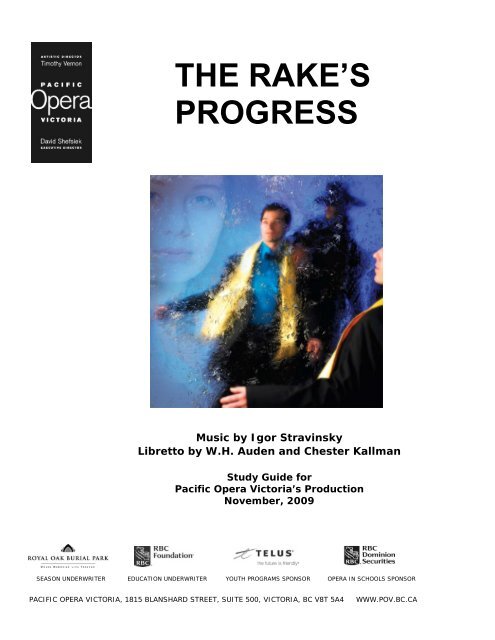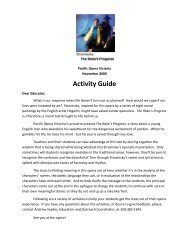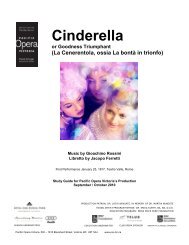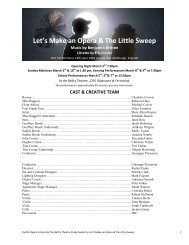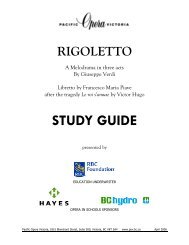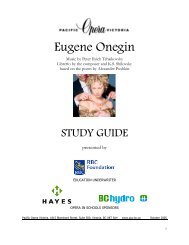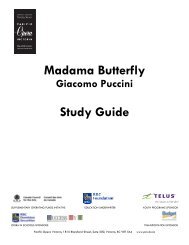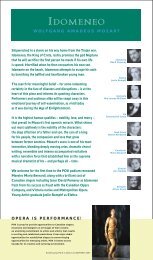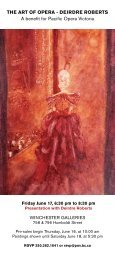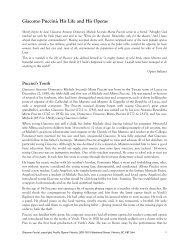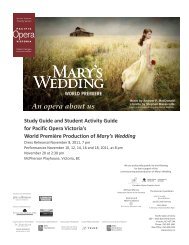POV Study Guide: The Magic Flute - Pacific Opera Victoria
POV Study Guide: The Magic Flute - Pacific Opera Victoria
POV Study Guide: The Magic Flute - Pacific Opera Victoria
Create successful ePaper yourself
Turn your PDF publications into a flip-book with our unique Google optimized e-Paper software.
collaborator. Kallman was Auden’s faithless lover and himself a fine model for a rake; the two would go on to cowritelibretti for other composers and to translate both <strong>The</strong> <strong>Magic</strong> <strong>Flute</strong> and Don Giovanni into English.Composer-librettist collaborations are fraught with challenges, but this was one of the happier ones. It may havehelped that Auden knew his place: early on he wrote to Stravinsky: As (a) you have thought about the Rake'sProgress for some time, and (b) it is the librettist's job to satisfy the composer, not the other way round, I should bemost grateful if you could let me have any ideas you may have formed about characters, plot, etc.Stravinksy later recalled the process of creating the story: Early the next morning, primed by coffee and whisky, webegan work on the Rake's Progress. Starting with a hero, a heroine, and a villain, and deciding that these peopleshould be a tenor, a soprano, and a bass, we proceeded to invent a series of scenes leading up to the final scene inBedlam that was already fixed in our minds. We followed Hogarth closely at first and until our own story began toassume a different significance.In March 1948, Auden and Kallman delivered what Stravinsky called surely one of the most beautiful of libretti.<strong>The</strong> composition of the music occupied the next three years. <strong>The</strong> result, in the words of composer Zeke Hecker, wasone of the few opera scores .. that are really love letters to the libretto. <strong>The</strong> opera premiered at Teatro la Fenice inVenice on September 11, 1951, conducted by the composer.CharactersStravinsky and Auden grafted the legend of Faust onto Hogarth’s Rake, adding the character of Nick Shadow toguide Tom into the brothels and gambling dens of sleazy old London. But Tom remains unexpectedly innocent and,at heart, faithful to Anne. As Baba explains to Anne,He’s but a shuttle-headed lad:Not quite a gentleman, nor quiteCompletely vanquished by the bad:Who knows what care and love might do?Tom Rakewell is every callow, overconfident, impulsive youth who ever stumbled upon love and ruin. <strong>The</strong>re’s alittle of Tom in every brother, son, and sweetheart who is fretted over by the people who care and fear for him.Despite his foolishness, there remains enough native goodness in Tom that he almost deserves Anne Trulove, whocomes from a long lineage of perfect, faithful loving Griseldas. Anne is pure and loyal and brave. And any sopranowould wage battle with tooth and claw to have the chance to sing her music.Rake brings us, in addition to its young lovers, a panoply of unforgettable characters, including Mother Goose, thebrothel keeper who snaps up Tom for herself; the suave, sinister Nick Shadow, who with Mephistophelean charmpropels Tom into ruin; the auctioneer Sellem, who presides over opera’s wackiest auction (this ne plus ultra ofauctions); and most exotic of all, Baba the Turk, the bearded lady from the circus, whom Tom marries – just toprove he can.Once one gets over the utter weirdness of seeing a bearded lady in the opera, one cannot but be charmed by Baba,whether she’s graciously greeting her adoring public, boring Tom silly with an inventory of her knick-knacks,smashing crockery in a rage, or generously informing Anne that Tom still loves her. Voluble and volatile, Baba isalso refreshingly honest and sublimely outspoken. And she gets to sing a patter song (As I was saying, both brotherswore moustaches) that is as divinely silly as anything by Gilbert and Sullivan.Musicologist David Schiff says, Baba was Auden's way of embodying his love for the genre of opera in all itsglorious absurdity. Baba breathes the spirit of opera itself... Morality is fine, she seems to say, but could we havesome entertainment, please?______________________________________________________________________________________________________<strong>Pacific</strong> <strong>Opera</strong> <strong>Victoria</strong> <strong>Study</strong> <strong>Guide</strong> for <strong>The</strong> Rake’s Progress 2009 7
<strong>The</strong> Composer, Igor StravinskyBorn in Russia in 1882, Igor Fyodorovich Stravinsky was mentored by Nikolai Rimsky-Korsakov and worked as acomposer first in Russia, then in Switzerland and France.As he began to make a name for himself in Russia with works influenced by Russian folk culture and music, hecame to the attention of the great Russian impresario Sergei Diaghilev, who asked Stravinsky to compose a ballet forthe celebrated Ballets Russes. <strong>The</strong> result, <strong>The</strong> Firebird (1910), was so successful that another commission quicklyfollowed for the ballet Petrushka (Petrouchka), which premiered in 1911 starring the great Russian dancer andchoreographer Vaslav Nijinsky.But it was his next ballet that established Stravinsky’s international reputation as an enfant terrible and THEquintessential modern composer. <strong>The</strong> iconic ballet <strong>The</strong> Rite of Spring exploded upon the 20 th century, inciting a fullscaleriot at its 1913 Paris premiere. Heralding a revolution in classical music, <strong>The</strong> Rite of Spring (Le Sacre duPrintemps) has been called the most famous musical work of the 20 th century, an icon of modernism, and the Rosettastone of modern art. Between Stravinsky’s music and Vaslav Nijinsky's choreography, this ballet about ritual pagansacrifice, with its intense rhythms and barbaric, inelegant dance movements was like nothing seen or heard before.<strong>The</strong> audience went crazy with catcalls, whistles, boos, fistfights and brawls, and the Paris police had to be called into restore order.Of <strong>The</strong> Rite of Spring, Leonard Bernstein said, It's also got the best dissonances anyone ever thought up, and thebest asymmetries and polytonalities and polyrhythms and whatever else you care to name.By 1940 a severely edited version of <strong>The</strong> Rite of Spring had found its way into Walt Disney’s Fantasia, and therevolutionary work had lost some of its capacity to scare audiences. But it still dazzles and is considered assignificant to the 20th century as Beethoven’s Ninth was to the 19th.When World War I broke out, Stravinsky moved to Switzerland; finances were tight, and he worked on smallerscale works such as the 1918 theatrical work <strong>The</strong> Soldier’s Tale, based on a Russian folk tale. After the RussianRevolution it became impossible for him to return to Russia, and in 1920, he settled in France where he began tocompose in the neo-classical style, re-examining the music of Mozart and Bach.In 1939 Katerina, Stravinsky’s wife of 33 years, died of tuberculosis; their eldest daughter had died the year before.When World War II broke out in 1939, Stravinsky moved to the US where he taught for a year at Harvard. Hestayed on in America, marrying his longtime mistress Vera de Bosset and settling with her in Hollywood.In 1941, to show his gratitude to his adopted country, Stravinsky harmonized and orchestrated his own arrangementof <strong>The</strong> Star-Spangled Banner. It was performed without incident in Los Angeles. But when he came to Boston in1944 to conduct it in a series of three concerts with the Boston Symphony, he ran afoul of a 1917 Massachusetts lawforbidding tampering with the National Anthem. Before the second concert, the Boston police arrived to confiscatethe sheet music.<strong>The</strong> law is still on the books in Massachusetts.CHAPTER 264. CRIMES AGAINST GOVERNMENTSChapter 264: Section 9. National anthem; manner of playingSection 9. Whoever plays, sings or renders the “Star Spangled Banner” in any public place, theatre, motion picture hall,restaurant or café, or at any public entertainment, other than as a whole and separate composition or number, withoutembellishment or addition in the way of national or other melodies, or whoever plays, sings or renders the “Star SpangledBanner”, or any part thereof, as dance music, as an exit march or as a part of a medley of any kind, shall be punished bya fine of not more than one hundred dollars.Source: http://www.mass.gov/legis/laws/mgl/264-9.htmThis law would theoretically make performances of Madama Butterfly illegal,as the opera quotes a brief excerpt of <strong>The</strong> Star-Spangled Banner.Shortly after the war ended, Stravinsky began to compose <strong>The</strong> Rake’s Progress. He was nearly 70 when <strong>The</strong> Rake’sProgress premiered in 1951; the opera seemed almost quaintly old-fashioned in a world where with-it composerswere conjuring up new harmonic adventures in atonality, aleatoric music, serialism, minimalism, and other isms ...not that Stravinsky would be left behind. Rake was his greatest – and last – neoclassical work.Stravinsky would soon begin exploring serial compositional techniques, including the twelve-tone techniqueoriginally devised by Arnold Schoenberg. He was influenced in this new direction by Robert Craft, a young______________________________________________________________________________________________________<strong>Pacific</strong> <strong>Opera</strong> <strong>Victoria</strong> <strong>Study</strong> <strong>Guide</strong> for <strong>The</strong> Rake’s Progress 2009 8
conductor whom he met in 1948. Craft became his musical aide and the two wrote a number of books aboutStravinsky’s life and musical views. <strong>The</strong> artistic partnership continued until Stravinsky’s death in 1971. Craft hasconducted throughout the world, and continues to be influential in supporting contemporary music; he is the firstAmerican to have conducted Alban Berg's operas Wozzeck and Lulu. He has conducted pioneering recordings ofworks by Schoenberg, Varèse, and Webern, and led the world premieres of several of Stravinsky's latermasterpieces.Stravinsky was a major influence on 20 th century music and many consider him the greatest of the century’scomposers.He won a number of Grammy awards:1961 Best Contemporary Classical Composition for Movements for Piano and Orchestra1961 Classical Album of the Year for Stravinsky Conducts Le Sacre de printemps; Petrouchka1962: Best Contemporary Composition for <strong>The</strong> Flood1962: Best Classical Performance – Orchestra – for Stravinsky, <strong>The</strong> Firebird Ballet1967: Best Classical Performance – Orchestra – for Stravinsky, Firebird and Petrouchka Suites1987: Lifetime Achievement AwardStravinsky also has a star on the Hollywood Walk of Fame at 6340 Hollywood Boulevard.<strong>The</strong> Librettists, Chester Kallman and W.H. AudenI chose Wystan Auden as librettist for my opera "<strong>The</strong> Rake's Progress" because of his special gift for versification ...I simply gave all priority to verse, hoping that we could evolve the theatrical form together and that it would inspireWystan to dramatic poetry. I think he was inspired, and in any case he inspired me ... I wonder whether any poetsince the Elizabethans has made a composer such a beautiful gift …Igor StravinskyW. H. Auden brought Chester Kallman in as co-librettist for <strong>The</strong> Rake's Progress. Kallman (1921 to 1975) was anAmerican poet, librettist and translator , whom Auden had met shortly after his arrival in New York in 1939.Kallman published three collections of poems, Storm at Castelfranco (1956), Absent and Present (1963), and <strong>The</strong>Sense of Occasion (1971) and wrote the libretto for an opera by Mexican composer Carlos Chávez and translatedlibretti for a number of operas, among them Bluebeard's Castle by Béla Bartók and Falstaff by Arrigo Boito.However, he is best known for being Auden's promiscuous lover and lifelong companion and for his collaborationswith Auden on opera libretti and translations.Wystan Hugh Auden (1907 –1973), best known as W. H. Auden, is considered by many to be the greatest Englishpoet of the twentieth century. He was born in York, England and studied at Oxford, majoring first in biology, andthen switching to English. He was part of a group of young intellectuals that included poets Cecil Day Lewis, LouisMacNeice, and Stephen Spender and novelist Christopher Isherwood, who was his mentor and later his lover.After graduation, Auden worked as a schoolmaster and as a freelance reviewer and essayist, and began to make aname for himself with his first collections of poems (1928, 1930, 1933, and 1934), each slightly different, all entitledsimply Poems. In 1937 he was awarded the King's Gold Medal for Poetry.Through his work with the General Post Office (GPO) Film Unit, he met composer Benjamin Britten, and the twocollaborated on the classic 1936 documentary Night Mail.In 1935 Auden married Erika Mann, daughter of the great German novelist Thomas Mann, in order to provide herwith a British passport to escape the Nazis. He served in the Spanish Civil War and in 1938 went to China withIsherwood to observe the Sino-Japanese War; out of this trip came their book Journey to a War.His political awareness and opposition to totalitarianism came out strongly in his writing of the time; a memorableexample is the concise little poem called Epitaph on a Tyrant, which he wrote around 1939, and which ends withthese lines:When he laughed, respectable senators burst with laughter,And when he cried the little children died in the streets.______________________________________________________________________________________________________<strong>Pacific</strong> <strong>Opera</strong> <strong>Victoria</strong> <strong>Study</strong> <strong>Guide</strong> for <strong>The</strong> Rake’s Progress 2009 9
In January 1939 Auden and Isherwood emigrated to America. Within three months Isherwood moved to California,while Auden settled in Brooklyn, where he met the poet Chester Kallman. <strong>The</strong> two became lovers; however, whileAuden saw their relationship as a marriage, Kallman was a philanderer; the relationship fizzled after two years,although the two remained friends, companions, and collaborators until Auden’s death.In 1940 George Davis, an editor recently fired from Harper's Bazaar (and the future husband of singer Lotte Lenya),leased a dilapidated house at 7 Middagh Street in Brooklyn Heights and invited Auden to move in. <strong>The</strong> buildingsoon became an exciting experiment in communal living, housing an amazing cross-section of American andexpatriate artists who, in between fighting and drinking, actually managed to get some work done. <strong>The</strong> building waschristened February House by writer Anaïs Nin because so many of the residents had February birthdays. <strong>The</strong>inhabitants – and the works they created while living in February House – included the following:<strong>The</strong> 23-year-old Carson McCullers, whose debut novel, <strong>The</strong> Heart Is a Lonely Hunter, had just been published,began work on her second great novel, <strong>The</strong> Member of the Wedding and the novella <strong>The</strong> Ballad of the Sad Cafe.British composer Benjamin Britten and his life partner , tenor Peter Pears. While living at February House,Britten collaborated with Auden on their first opera Paul Bunyan.Klaus Mann, son of the great novelist Thomas Mann, wrote the autobiographical <strong>The</strong> Turning Point.Composer and writer Paul Bowles wrote music for Pastorela, a Mexican Indian ballet, while his wife, Jane,worked on her novel Two Serious Ladies.<strong>The</strong> stripper Gypsy Rose Lee, who desperately wanted to be a writer, wrote a mystery thriller called <strong>The</strong> G-String MurdersVisitors to the house included a who’s who of American and European artists, among them painter Salvador Dali,poet Louis MacNeice, choreographer George Balanchine, and composers Virgil Thomson. Aaron Copland, MarcBlitzstein (composer of <strong>The</strong> Cradle Will Rock and Regina) and Leonard Bernstein.February House has been called a Petri dish for literary creativity. When Swiss writer Denis de Rougemont visitedthe house, he wrote, All that was new in America in music, painting, or choreography emanated from that house,the only center of thought and art that I found in any large city in the country'<strong>The</strong> hotbed of creativity that was February House inspired a 2005 book by Sherill Tippins: February House: <strong>The</strong>Story of W. H. Auden, Carson McCullers, Jane and Paul Bowles, Benjamin Britten, and Gypsy Rose Lee, Under OneRoof In Wartime America.Auden left February House in the fall of 1941 to teach at the University of Michigan; the other residents driftedaway, and in 1945, the house was demolished to make room for the Brooklyn-Queesns Expressway.Auden continued to work as a poet, reviewer, lecturer and editor. He taught at various schools and universities andbecame a US citizen in 1946. From 1956 to 1961 he was a professor of poetry at Oxford. His long poem <strong>The</strong> Age ofAnxiety won the 1948 Pulitzer Prize for poetry.After writing the libretto for Stravinsky’s <strong>The</strong> Rake’s Progress, Auden and Kallman collaborated on two libretti forHans Werner Henze, Elegy for Young Lovers (1961) and <strong>The</strong> Bassarids (1966), and on the libretto of Love'sLabour's Lost for Nicolas Nabokov (1973). <strong>The</strong>y also collaborated on translations of Mozart’s <strong>The</strong> <strong>Magic</strong> <strong>Flute</strong> andDon Giovanni, and on translations of Seven Deadly Sins and <strong>The</strong> Rise and Fall of the City of Mahagonny by KurtWeill and Bertolt Brecht.As a librettist, Auden is frequently compared to the great Hugo von Hofmannsthal. His libretto for <strong>The</strong> Rake’sProgress continues to be admired for its beauty, wit, and profundity, and Auden is widely considered the 20 thcentury’s finest librettist.Auden was a longtime friend of J.R.R. Tolkien, and among the most prominent early critics to praise <strong>The</strong> Lord of theRings when it was first published in 1954. Tolkien wrote of his support, I am... very deeply in Auden's debt in recentyears. His support of me and interest in my work has been one of my chief encouragements. He gave me very goodreviews, notices and letters from the beginning when it was by no means a popular thing to do. He was, in fact,sneered at for it.In 1972 Auden moved back to England, but spent his summers in Austria. He died in Vienna in September, 1973.W.H. Auden continues to be seen as one of the greatest literary figures of the 20th century.______________________________________________________________________________________________________<strong>Pacific</strong> <strong>Opera</strong> <strong>Victoria</strong> <strong>Study</strong> <strong>Guide</strong> for <strong>The</strong> Rake’s Progress 2009 10
Auden's popularity and familiarity increased after his poem Funeral Blues was read aloud in the 1994 film FourWeddings and a Funeral (1994).Stop all the clocks, cut off the telephone,Prevent the dog from barking with a juicy bone,. . .He was my North, my South, my East and West,My working week and my Sunday rest,My noon, my midnight, my talk, my song;I thought that love would last forever: I was wrong . . . .<strong>The</strong> MusicI chose to cast "<strong>The</strong> Rake" in the mould of an eighteenth-century "number" opera, one in which the dramatic progress dependson the succession of separate pieces -- recitatives and arias, duets, trios, choruses, instrumental interludes ...Having chosen aperiod-piece subject, I decided -- naturally, as it seemed to me -- to assume the conventions of the period as well.Igor Stravinsky<strong>The</strong> Rake’s Progress represents the culmination of Stravinsky’s neo-classical period – it’s a throwback to Mozarteanstructure, an opera of formally constructed arias, recitatives and choruses. It uses a small chamber orchestra andeven calls for a harpsichord to provide recitativo secco (to quite unnerving effect in the graveyard scene). But themusic retains its 20 th century twist; it’s pure Stravinsky, full of his idiosyncratic spiky rhythms and unexpectedlyricism.As musicologist Gunther Schuller put itRake is Mozart revisited, to be sure, but by a genius who has shown us aspects of Mozart we have never seenbefore. It’s an extraordinary love affair with harmony… ravishingly beautiful sounds, filtered and savored byone of the greatest musical ears of all time.20th century Neoclassicism in musicThroughout cultural history, there is an artistic pendulum that moves between classicism and romanticism. Forexample, the classicist Gluck moves to the romanticist Wagner through the works of Mozart and Beethoven. In theunusual case of Igor Stravinsky, the pendulum can be seen moving through the works of a single artist.In his youth, Stravinsky was known as the avant garde post romanticist capable of exposing the most basic humanemotions in earthy rhapsody. His middle period was absorbed with exploring the style and order of his classicalpredecessors, while he concluded his compositional life working in the serial/twelve tone manner, the intellectualcomplement to the emotional basis of his youthful inspiration.<strong>The</strong> Rake’s Progess is one of the central works of his middle period, and is accordingly linked to composers andcompositions of the past.We invite you to join us on our website for a “curated” view of these influences, using YouTube excerpts as ourmusical source book.VerdiAnne Trulove’s Act I aria No word from Tom is comparable to any number of bel canto arias. It begins with arecitative followed by a slow section (cavatina), interrupted by another recitative, then ends with a fiery coloraturasection (cabaletta). Compare this aria with Violetta’s Act I aria , Ah fors’e lui, Sempre Libera in La traviata. In thisform, the singer can use all of her vocal capabilities to reveal character and advance the story.http://www.youtube.com/watch?v=skUwYWwX7msElizabeth Futral as Violetta in Verdi's La traviatahttp://www.youtube.com/watch?v=Xo2LtFXlgA8Dawn Upshaw as Anne Trulove in <strong>The</strong> Rake's Progress______________________________________________________________________________________________________<strong>Pacific</strong> <strong>Opera</strong> <strong>Victoria</strong> <strong>Study</strong> <strong>Guide</strong> for <strong>The</strong> Rake’s Progress 2009 11
Mozart<strong>The</strong> references to Mozart are many. Un aura amorosa, Ferrando’s Ode to Love, from Così fan tutte is theundeniable influence for Tom’s darker, slightly twisted ode, Love, too Frequently betrayed. Note the same rhythmicstart to the introduction, as well as the expansive melody.http://www.youtube.com/watch?v=QXEjZqYhgQQJonas Kaufmann as Ferrando in Mozart's Così fan tuttehttp://www.youtube.com/watch?v=Zo_K6PcFJ-kCristian Mogosan as Tom Rakewell in <strong>The</strong> Rake's Progress<strong>The</strong> scene in the churchyard in <strong>The</strong> Rake's Progress is strongly reminiscent of the finale of Mozart's Don Giovanni(another tale of a rake). In Don Giovanni of course, it is the rake himself who is taken to hell. In <strong>The</strong> Rake'sProgress Nick Shadow sinks into the grave.http://www.youtube.com/watch?v=dK1_vm0FMAUSamuel Ramey as Don Giovanni and Kurt Moll as the Commendatore in Mozart's Don Giovannihttp://www.youtube.com/watch?v=flN9OBlfsjgSamuel Ramey as Nick Shadow in <strong>The</strong> Rake's ProgressMonteverdi<strong>The</strong> final scene of <strong>The</strong> Rake’s Progress owes a great deal to the 16 th century operas of Monteverdi. <strong>The</strong> freerecitative, the references to gods and the hope of rescue are common to both.http://www.youtube.com/watch?v=8V0Y6wSLIqUVittorio Prato in the title role in Monetverdi's Orfeohttp://www.youtube.com/watch?v=f_EHY6CQ43QEdward Randall as Tom in <strong>The</strong> Rake's Progress (in German)______________________________________________________________________________________________________<strong>Pacific</strong> <strong>Opera</strong> <strong>Victoria</strong> <strong>Study</strong> <strong>Guide</strong> for <strong>The</strong> Rake’s Progress 2009 12
<strong>POV</strong>’s ProductionThrough its music, its structure, and its story, <strong>The</strong> Rake’s Progress is an intriguing fusion of time and place. Itinhabits at once the 18 th century of Mozart and Hogarth, the 19 th century in which this production is set, the 20 thcentury of its creators, and the 21 st century of here and now – not to mention those places outside time – Heaven andHell, Bedlam, and the peculiar alternate universes in which Baba is suspended in time and Tom roams in hismadness.<strong>POV</strong>’s original production of <strong>The</strong> Rake’s Progress is beingbuilt in our own production shop. Director Glynis Leyshonhas set this production in the Regency period of the veryearly 19 th century. Nancy Bryant’s costumes will bringelegance and the ambience of old London to the production,along with touches of the exotic and decadent in thecostumes for Baba and Mother Goose.Allan Stichbury’s simple set allows a colourful canvas forthe theatrical shenanigans, fantastic baroque machine, giantfish, and other wonders of this opera. <strong>The</strong> set design uses aseries of frames which impart a deep sense of perspective toeach scene, allowing a rich opportunity to play with timeand place throughout the opera.At right are photos of models for the set designed byAllan Stichbury. Below are Nancy Bryant's costumesketches for Anne Trulove (left) and Baba the Turk(right).Photo of set model for Chapter 6: Inside Tom'sTownhouse. Nick enters, wheeling in a fantastic baroquemachine , and demonstrates how, through a hiddencompartment, the machine can appear to turn a broken pieceof china into a loaf of bread.Photo of set model for Chapter 6: Inside Tom'sTownhouse.Tom is bankrupt. Sellem the auctioneer directs the bidding ashis possessions are auctioned off, including including a stuffedauk, a mounted pike, and Baba herself.______________________________________________________________________________________________________<strong>Pacific</strong> <strong>Opera</strong> <strong>Victoria</strong> <strong>Study</strong> <strong>Guide</strong> for <strong>The</strong> Rake’s Progress 2009 13
Links<strong>The</strong> Rake's Progresshttp://www.teatroallascala.org/includes/doc/2008-2009/libretto/rakes_libretto.pdfLibretto in English with Italian translationIgor Stravinskyhttp://en.wikipedia.org/wiki/Igor_StravinskyBiography of Stravinsky, discussion of his work and linkshttp://www.archive.org/details/lullaby_and_final_hymnVideo of Stravinsky conducting 'Lullaby and Final Hymn' from the "Firebird Ballet Suite" in a1965 performance with the New Philharmonia Orchestrahttp://www.archive.org/details/conversationswit000800mbpConversations with Igor Stravinsky(1959), a book by Igor Stravinsky and Robert Crafthttp://www.archive.org/details/igorstravinskyan002221mbpIgor Stravinsky An Autobiography (1962)W.H. Audenhttp://en.wikipedia.org/wiki/W._H._AudenBiography of Auden, discussion and linkshttp://www.youtube.com/watch?v=JPLHOOtlcnMNight Mail: Excerpt from the famous 1936 GPO documentary with music by Benjamin Britten andthe poem by W.H. Auden.http://audensociety.org/<strong>The</strong> W. H. Auden Society: Links to information about W.H. Auden, and to some of his poemshttp://www.poets.org/poet.php/prmPID/120Brief Biography of Auden, links, and text of some of his Poemshttp://www.npr.org/programs/death/readings/poetry/aude.htmlTwo more poems by Auden (Funeral Blues and Johnny)http://www.nytimes.com/1954/10/31/books/tolkien-fellowship.htmlAuden's 1954 review of J.R.R. Tolkien's <strong>The</strong> Fellowship of the Ring (first volume of <strong>The</strong> Lord ofthe Rings) From the New York Times Archiveshttp://query.nytimes.com/gst/fullpage.html?res=9507EFDE113BF935A35751C0A9639C8B63Genius and High Jinks At 7 Middagh Street: Article by Sherill Tippins in the New York Timesabout the house on Middagh Street, which Auden shared with Carson McCullers, BenjaminBritten, Gypsy Rose Lee, and othersChester Kallmanhttp://en.wikipedia.org/wiki/Chester_KallmanBiography of Kallman with linksWilliam Hogarthhttp://www.statemaster.com/encyclopedia/William-HogarthBiography and overview of Hogarth's workshttp://en.wikipedia.org/wiki/A_Rake's_ProgressA Rake's Progress: Detailed descriptions and large images of the series of eight paintings byHogarth that inspired Stravinsky's opera, as well as images of the series of eight engravings thatHogarth created later.______________________________________________________________________________________________________<strong>Pacific</strong> <strong>Opera</strong> <strong>Victoria</strong> <strong>Study</strong> <strong>Guide</strong> for <strong>The</strong> Rake’s Progress 2009 14


